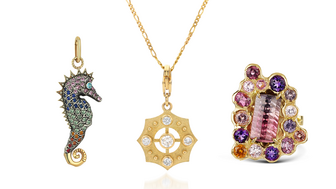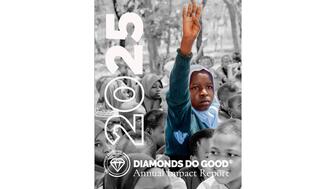As the shopping mall model evolves and online retail grows, Smith shares his predictions for the future of physical stores.
The History Behind … Dress Clips
What inspired these popular Art Deco-era pins, and what forced them out of fashion? A look at the story behind a style that’s similar to the brooch.

New York--Dress clips are a type of pin that first gained prominence in the 1920s and were worn in pairs, often opposite one another on the neckline or straps of a dress.
The style, however, fell out of favor in the 1950s when classic brooches regained popularity, and it never really recovered.
So, what forced dress clips out of fashion, and will they ever come back in style again?
Greg Kwiat, CEO of Fred Leighton, and Rebecca Selva, chief creative officer and public relations director for the jeweler, recently took the time to chat with National Jeweler about this Art Deco-era trend, and some of the ways in which Fred Leighton is finding new life for these classic clips.
When did women first start wearing dress clips? Dress clips, Kwiat said, first began to appear post-World War I. Fashion in both clothing and jewelry changed as the world worked to recover from the “Great War” and time marched on into the 1920s, a famous decade for style.
During this time, “fashion began to dictate some of the jewelry trends” in many respects, Kwiat said. “The tight, corseted dresses of the Edwardian period came into a much more free-form flowing, adventurous, romantic style,” including the famous flapper dresses of the era.
This new style of dress called for more ornamentation, and Kwiat said dress clips evolved as a reaction to that and were worn not only on dresses but also on furs and accessories, like handbags.
“I think it’s a real phenomenon in a way because dress clips become the piece of jewelry you have to have, and becomes integral to a dress and a look,” Selva said. “Designers are putting them on these dresses that they are making. Some of the big thrust was the movies, people going to the movies in the 1920s, and they’re seeing these beautiful women with these dress clips and they want that.”
And so companies started making them in great number, and not just the great houses such as Cartier, Van Cleef & Arpels and Raymond Yard, but famous costume jewelers of the era too, like Trifari and Coro. This, in turn, feeds back to the fine houses and the dress clip quickly establishes itself as a “must-have item in fashion,” Kwiat said.
“The costume jewelry industry,” Selva said, “gave such a boost to that concept.”
Did dress clips serve any purpose?
What separates the dress clip from the classic brooch? Kwiat said in the beginning, dress clips were always in pairs, worn separated from each other on the strap or neckline of a dress, and almost always symmetrical.
However, they also could be worn together. He said pairs of dress clips often had a back that secured the two halves together so it became one piece, like a more classic-style brooch.
“That’s really the difference,” he said. “The dress clips are two pieces that can be worn together or separate whereas a brooch is typically a single element.”
Kwiat added that the Art Deco period is also the first time dress clips appeared, whereas one could go as far back as the Ancient Egyptians and find brooches.
When do we see dress clips begin to decline in popularity? In the 1930s and ‘40s, the style of dress clips evolved alongside other jewelry.
The bright-white platinum and diamond aesthetic of the early Art Deco era expanded to incorporate yellow gold and more colored gemstones and asymmetry became more of an acceptable idea.
As World War II ended, though, styles began to change.
Kwiat noted that during the Great Depression and the World War II, people went to the movies to escape and were inspired by the styles of actresses like Jean Harlow, Greta Garbo and Marlene Dietrich, who were featured on screen and in images wearing dress clips.
“(Dress clips are) never going to be what (they were) before but I always want to think that there’s people out there who love it and will wear them and enjoy them.” --Rebecca Selva, Fred LeightonBut then, “World War II ends, times change, fashions change,” he said. “And in the 1950s, the brooch really resurges in popularity and dress clips become less popular. You see dress clips fade a little bit in the minds of consumers.”
And they really never made a comeback.
“Dress clips really occupy a very distinct moment in time and they kind of bring you back to the ‘20s, ‘30s and ‘40s,” Kwiat said.

Do you think the dress clip will ever regain the same type of popularity they enjoyed in the 1920s? “I pray every day for that,” Selva laughed. “You know what, it’s never going to be what it was before, but I always want to think that there’s people out there who love it and will wear them and enjoy them.”
Kwiat agreed, “It will never be as popular as it was in the 1920s.”
While today’s more casual dress doesn’t lend itself to the traditional manner of wearing dress clips, Selva noted that there are different ways of donning them today. Some women wear a single clip to dress up a pair of black pants while others tuck them into updos to add some glamour to the hair.
Fred Leighton, too, has found ways of incorporating beautiful Art Deco-era dress clips into modern-looking pieces of jewelry. “When we see beautiful dress clips, sometimes we feel they can make the basis of a beautiful design of some other kind,” Kwiat said.
The jeweler crafted a black enamel bangle with a pair of platinum diamond, ruby and onyx dress clips in mind. They also have designed big, modern earrings incorporating dress clips with on-trend styles such as yellow gold and fringe.
This reflects another trend seen throughout the history of jewelry--versatility, the desire to craft pieces that can be worn in multiple ways.
“People were always thinking about how they could wear things differently and more often,” Kwiat said.
The Latest

The trade show is slated for Jan. 31-Feb. 2 at The Lighthouse in New York City's Chelsea neighborhood.

The annual report highlights how it supported communities in areas where natural diamonds are mined, crafted, and sold.

How Jewelers of America’s 20 Under 40 are leading to ensure a brighter future for the jewelry industry.

Footage of a fight breaking out in the NYC Diamond District was viewed millions of times on Instagram and Facebook.


The supplier has a curated list of must-have tools for jewelers doing in-house custom work this year.

The Signet Jewelers-owned store, which turned 100 last year, calls its new concept stores “The Edit.”

Roseco’s 704-page catalog showcases new lab-grown diamonds, findings, tools & more—available in print or interactive digital editions.

Linda Coutu is rejoining the precious metals provider as its director of sales.

The governing board welcomed two new members, Claire Scragg and Susan Eisen.

The master jeweler, Olympian, former senator, and Korean War veteran founded the brand Nighthorse Jewelry.

In its annual report, Pinterest noted an increase in searches for brooches, heirloom jewelry, and ‘80s luxury.

Executive Chairman Richard Baker will take over the role as rumors swirl that a bankruptcy filing is imminent for the troubled retailer.

Mohr had just retired in June after more than two decades as Couture’s retailer liaison.

Shekhar Shah of Real Gems Inc. will serve as president of the Indian Diamond & Colorstone Association in 2026.

This year’s good luck charm features the mythical horse Pegasus, and is our first Piece of the Week of the new year.

Articles about crime, engagement rings, and a necklace worn in the World Series generated the most interest among readers.

As part of the leadership transition, Sherry Smith will take on the role of vice president of coaching strategy and development.

It marks the third time the country has headed the Kimberley Process. Ghana will serve as vice chair.

The new Bulova x Stetson designs highlight two animals often associated with the American West—the bison and the Texas Longhorn.

Its residency at Yamron Jewelers will run through May 2026.

From influential executives to innovative designers, we pay tribute to the people we said goodbye to this year.

The retailer is expanding into areas with large Indian and South Asian populations.

The Italian brand has opened its first flagship amid the peaks of the Dolomites in Madonna di Campiglio, Italy.

The new curation at the Natural History Museum of Los Angeles County showcases rare gem and mineral specimens in their uncut, natural state.

The couple pleaded guilty to concealing at least $127 million in cash transactions at its precious metals businesses.

Consumers shared concerns about prices, inflation, tariffs, trade, and politics in the survey’s write-in response section.


























